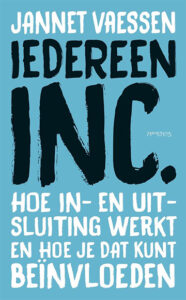
Career advice for underdogs
Published on: 17 Jan 2022Jannet Vaessen is Executive Director and Founder of WOMEN Inc. They’ve been using research, public and political campaigns, workshops and events since 2005 to work towards a society with equal opportunities for all, regardless of gender or sex. Top of Minds sat down with Jannet to talk about fighting social inequality and creating a level playing field in the labor market. Read her career advice for people who fall outside the current norm here.
Tip 1: Be aware of the injustice that awaits you.
Jannet never expected to become a leader in the Dutch women’s movement. “No one wants to identify with the victim or the underdog until they’re there themselves. As a young, white educated woman with blond hair and blue eyes, I felt like I had the wind at my back, but I didn’t realize there would come a day when that spell would break.” That realization only came when her employer tasked her with developing a new women’s platform—not just for old guard feminists, but for all women. That platform became WOMEN Inc., and it’s grown into an unparalleled success.
“WOMEN Inc. helped me start thinking about social inequality. Statistics show that certain groups of young women do better than men, in education and on the career ladder. But around age of 30, they move to the next phase of life, by choice, from choice overload, or just because of how life goes. And it’s only after 40 that many women look back up and realize that their opportunities are significantly limited compared to men.” So, Jannet’s first career tip is to be wary of the ways in which the mechanism of inclusion and exclusion may affect you.
Jannet Vaessen’s CV
2019 – present: Executive Director, WOMEN Inc.
2019 – present: Coordinator for Sustainable Development Goal 10 – Reduce Inequality, Ministry of Foreign Affairs
2020 – present: Initiator, Social Sustainability Alliance
2017 – present: Author of IEDEREEN Inc. (EVERYONE Inc.)
2019 – 2020: Co-coordinator for SDG 5 – Gender Equality, Ministry of Foreign Affairs
2005 – 2019: Founder/General Manager, WOMEN Inc.

Tip 2: Don’t settle for diversity.
Appearance, heritage, sex, education, income, religious beliefs—there are many criteria that groups use to include and exclude people. As more and more organizations work towards diversity goals, it’s becoming increasingly challenging to not only attract people with a different profile but to retain them within the organization over the long term.
Jannet says, “If someone is the only one representing a minority in a group, that’s called a token. Think of the black kid on South Park, his name is literally Token. If it never goes beyond that single employee with a different profile, the ‘other’ is often prized for being different; jokes about differences are seen as harmless and come with minimal consequences. But when a group brings in more people with ’different profiles’, things get a lot trickier.
If ‘the other’ does something right, that success is attributed to the in-crowd. But as soon as they make a mistake, it’s because of their ‘otherness,’ e.g., ’Of course, women are so emotional…’. You often see a mass exodus of ‘the others’ at this stage. The percentage of ‘the other’ has to top 25% before failures and successes are seen as individual achievements. Group members are more likely to feel at home with this mix of people and attract more diverse people from other groups. The different profiles are given space to grow and establish shared group values together. This final stage is called inclusion. As an organization, you have to have a good understanding of which stage you’re in and how to move to the next stage.”
Tip 3: Show that you are fighting.
What’s the best course of action if you represent a minority in an organization that hasn’t reached the final inclusion stage yet?
Jannet explains, “When you look at how much injustice someone experiences, and how they address that injustice, you can divide people into four types. People who don’t experience much injustice and aren’t really actively addressing it are called the golden geese. Then there’s the category of people who experience some minor injustice but very actively address that injustice, they’re called the go-getters. Then there are two categories of people who actually experience significant injustice but handle it either passively or actively. The victim type complains about the injustice but doesn’t take any action to fight it. The underdog, on the other hand, is unmistakably fighting injustice. That’s not to say the underdog can solve every problem on their own, but it does mean they’re taking on the fight themselves instead of waiting for someone else to act.”
After 16 years in the women’s movement, there’s only one type of person Jannet doesn’t take well to: “The type that stays but doesn’t fight. If I’m going on and on about injustice with someone without coming up with concrete action points or proposals, I can see it happening: everyone loses interest. So, if you’re experiencing injustice, the most effective approach is standing up for yourself as an underdog. Show that you’re fighting. Always be sure to highlight your approach, your strategy, your actions, what you’ve already accomplished, what you’re going to do, who you already have under your belt, demonstrate how many people you represent, and how achieving your goals will benefit others.”
“Diversity is chasing a certain mix in your group numbers, so you can check a box in your annual report. Inclusiveness is the belief that all profiles add value to a group. Diversity is being invited to the party, inclusion is being asked to dance.”
Tip 4: Don’t assume the rest of the world is waiting to hear your ideas.
In her fight against gender inequality, Jannet has encountered a lot of explicit and implicit resistance—from top business leaders who dismiss the wage gap to cardiologists who obstinately continue to prescribe the same medication in the same dosage for all patients, even when it’s been scientifically proven that the drug can have side effects for women in certain dosages. “Well, when you represent a marginalized group, you’ll encounter that same dynamic when you come up with a new insight: the people around you aren’t necessarily waiting with bated breath to hear it. No matter how fantastic your idea or insight is, the stages a new idea must always go through are: Denial, Resistance, Embarrassment, Acceptance, That’s What I’ve Always Said. If you can see beyond the process, you can focus all of your energy on how to shepherd your idea through the various stages, and you won’t get discouraged unnecessarily.”

Tip 5: Resistance is a good sign.
Anyone who launches a new idea will initially find that people simply don’t listen. But those who persevere will enter the “resistance” phase. Hallmarks of this phase are accusations that this idea doesn’t make scientific or legal sense, the numbers don’t add up, or however it’s phrased. Jannet continues, “Don’t see this as an attack or a death knell, see it as the first signal that you’re being taken seriously. However much the other person’s goal may be to still be able to dismiss you, you’re one step further and no longer being ignored. Be fully prepared to provide solid evidence at this stage, with numbers, studies or arguments as to why you have a different perspective than the way things have always been done. And most importantly, why this may actually benefit the other person.”
Tip 6: Don’t take it personally.
“The next phase is the most difficult for a lot of people,” Jannet knows. “You’ve stood your ground by your evidence or argument, and now you’re being personally attacked. ‘He’s a lot less sharp than he used to be…’ or ‘She’s pretty emotional, don’t you think?’ or ‘Is she acting that way because of her Jewish background?’ In short, mechanisms emerge to make it seem like you’re outside the realm of normal people and common ideas. That’s even more likely if you’re part of a marginalized group. Now it comes down to whether you, with your new ideas, can push through this phase to take the idea one step further. Do you have enough Teflon on your back to let all the personal mudslinging slide right off? To see it as a necessary phase to build support for your idea? Hang in there! In the end, these barbs aren’t really directed at you personally; the people around you are just getting ready for your new idea. But before the old way can be left behind, they need to get in one more jab to make sure it’s worth taking you seriously.”
Tip 7: Celebrate your victory, even when it’s anonymous.
“And then, right after that, completely unexpectedly, you’ll suddenly find yourself in the last few stages at once. ‘Acceptance.’ As if it were the most natural thing in the world, you’ll hear someone spouting your idea. The thing you’ve been saying for ages, but no one wanted to hear. And right after that comes ‘That’s what I’ve always said’. Everyone suddenly seems to think the idea makes complete sense, and that they’re actually the ones that thought of it in the first place. Success has many parents, as they say. So now you’ll never get the credit for powering through all the headwinds and resistance. Now it’s just exactly the way you said it was. Now it belongs to everyone. The most important thing at this stage? Don’t get stuck in your own rightness, don’t be disappointed when you don’t get many pats on the back and keep your original goal in mind. You went to bat for that new insight, and it’s been added to the cloud of assumptions and things we take for granted that are what our history is built on.”
